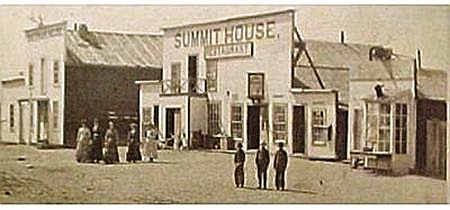
Sherman, approx. 1870
Within 15 months of the railroad reaching Sherman Hill, the town boasted railroad
machine shops, a Wells Fargo express office, a newspaper, a millinery store and, as indicated
by the photo to the right, 2 two-story false fronted hotels,
the Sherman House and the Summit House. They were not
much as hotels but featured decent meals. Next door to the hotels was
a bar. But as an early tourist destination the town received mixed reviews. An early English
tourist, William Fraser Rae, noted of Sherman:
Some writers strongly advise the traveller to make a halt at Sherman station. The
inducements held out to him are mountain scenery, invigorating air, fishing, and hunting.
A sojourn among the peaks of the Rock Mountains has the attraction of novelty to recommend it.
Life ther must be, in every sense of the word, a new sensation. But some sensations are
undesireable notwithstanding their undouted freshness. That splendid trout swarm in the
streams near Sherman admits of no dispute. Yet the disciple of Isaac Walton should not be
tempted to indulge rashly in his harmless and charming sport. It is delightful to hook large fish; but
is less agreeable to be pierced through by arrows.W. Fraser Rae: Westward by Rail: A Journey to San
Francisco and Back and a Visit to the Mormons; W. Isbister & Co., London, 1874, "Third and Cheaper Edition."
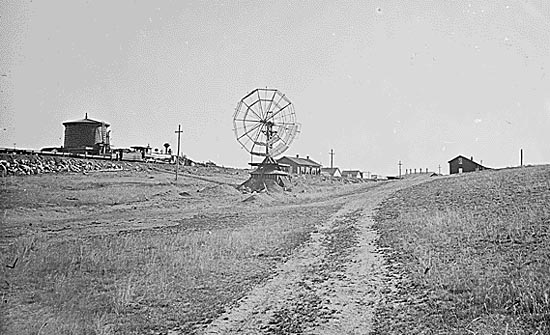
Sherman, 1869, photo by Wm. H. Jackson
Rae continued:
The scenery around Sherman is bleak and wild. Several famous peaks are said to be
perceptible in the far distance. I have read a statement to the effect that Long's Peak, one
of the principal mountains of Colorado, 75 miles to the South-west, and Pike's Peak, 165 miles to the
South are "both plainly visible." To the North, Elk Mountain is "another noted landmark," about 100 miles
distant. It is possible that these mountain tops may have been discerned in a vision by
the complilers of guide books. to the eye of the ordinary and unimaginative traveler they are
invisible.
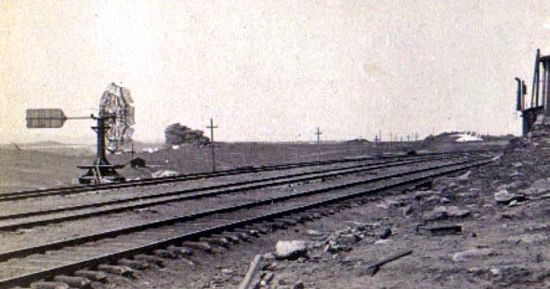
Windmill and water tank at Sherman, Photo by Wm. H. Jackson, 1869
In his 1877 book, The Pacific Tourist, Henry T. Williams, described the weather
at Sherman:
At Sherman, the snow never falls very deep, but there is a constant breeze, that
most Eastern opople would pronounce a gale, and the snow is constantly drifting and packs so
hard whenever it finds lodgment, that it is exceedingly difficult to displace,
requiring an immense power of snowplows, engines and shovelers.
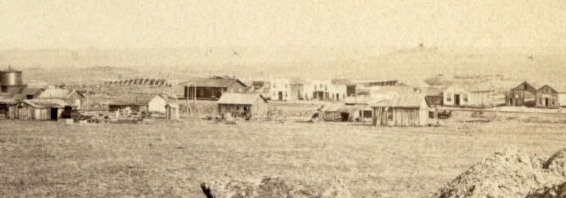
Sherman, approx. 1870, from stereograph by C. R. Savage
Charles Roscoe Savage (1832-1909) was born in Southhampton, England. After conversion to
the Latter Day Saints at age 14, he went on Mission in England and Switzerland before emigrating
to the United States in 1855. The voyage took 66 days through gale and storm and when the vessel
arrived in New York it had only a one day's supply of drinking water left.
Other ships making the crossing at the same time were lost. Savage attributed the vessel's
arrival, without so much as the loss of a spar, to Divine Intervention. In New York, Savage married the
first of his four wives and appears to have followed a now discarded practice of 19th
Century Mormonism. [Writer's Notes:
Annie Adkins (1836-1893), m. June 24, 1856; Ellen Fenn (1843-1925), m. Aug. 19, 1871; Mary Emma Fowler
(1836-?), m. Oct. 12, 1876;Annie Clowes (approx. 1836-?), m. Oct. 15, 1895].
As a photographer he is most famous for his documentation of
Utah. His most noted photographs are those of the driving of the golden spike and a photo of
Brigham Young.
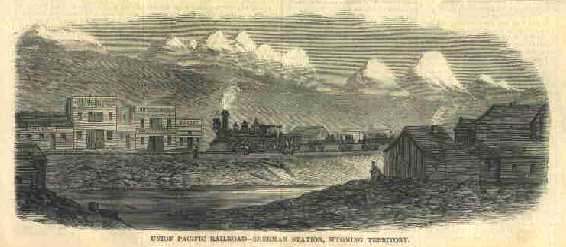
Sherman, 1869, woodcut, Harper's Weekly
Today, the existence of the town is marked only by the Ames Monument,
pictured on previous pages, constructed by the Union Pacific in 1882; the foundation stones for
the railroad's windmill; and the cemetery. See photos of windmill foundation and
cemetery toward bottom of page.
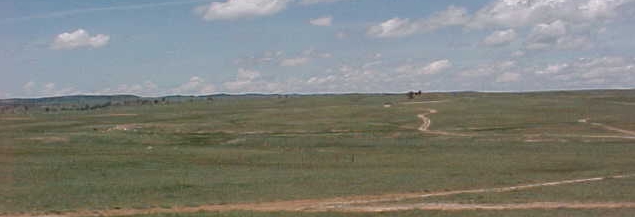
Sherman, 2001, looking west, photo by Geoff Dobson
The town site of Sherman is depicted in the
above photo. In the center of the photo,
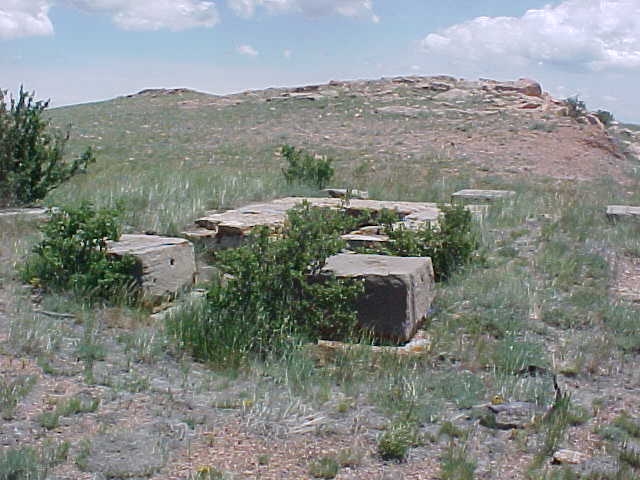 running from left to right, is the former
railroad right-of-way. Toward the left of center may be made out the town site. To the
right of center a trail meanders up the hill to the cemetery. running from left to right, is the former
railroad right-of-way. Toward the left of center may be made out the town site. To the
right of center a trail meanders up the hill to the cemetery.
Foundation stones railroad yard, photo by Geoff Dobson
Sherman had as a part of the railroad yards a windmill
the vanes of which had a diameter of 20 feet.
It was used to pump water into a tank holding 50,000 gallons.
Additionally, the yard had a roundhouse with five stalls and a turntable. The railroad shops
were required, in great part, by the necessity of double-heading the locomotives up
the steep grade from Laramie. Even today in wintertime the grade on the Interstate out of
Laramie can be an adventure.
In 1901, with the
construction of the Dale Creek embankment, the railroad
tracks were moved several miles away. Today, as indicated by the
above photos, little remains except pottery shards and rusted tin cans. Some artifacts,
however, are newer. On the day that the above photo was taken, a faded Pepsi
can bearing the 1984 football schedule for the Wyoming Cowboys was found. As all
historical artifacts should be, it was left in place.
Williams, in his book, made note of the cemetery. Not much has changed:
As you approach Sherman, you will see the balanced rocks, and to the right of the
station, about one-quarter of a mile, is a rugged peak, near which are graves of some who are
quietly sleeping so near heaven, and a solitary pine tree, like a sentinel keeping guard over them.
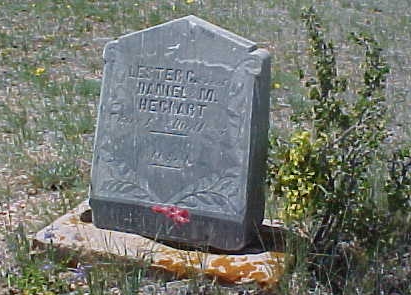 Child's grave Sherman Cemetery, photo by Geoff Dobson
Child's grave Sherman Cemetery, photo by Geoff Dobson
With the abandonment of the town, many of the remains were removed by relatives to
cemeteries elsewhere. The photo is of the grave of a one-year old child who
died in 1888. Today, on the lonely, windswept knoll a 1/4 mile west of Sherman,
Mother Nature provides the flowers.
Rae continued, "It is with a feeling of relief that Sherman station is left behind. The train
descends by its own weight the rapid incline which leads to the Laramie Plains. Three miles
westward of Sherman the line crosses Dale Creek on one of those wooden bridges which appear so unsubstantial, yet are said
to be so stong."
Directions to Sherman. Exit I-80 at Vedauwoo Road, approximately 16 miles east of
Laramie. Follow signs on graded road on south side of Interstate to Ames Monument. Last portion is on
unimproved road. Town site is approximately 1/4 mile west of monument.
The Town Site of Sherman
is private property
The Owners have requested
NO TRESPASSING
Thank you
G.B.D. |
Music this page:
Put My Little Shoes Away
Music by Charles E. Pratt (1841-1902)
Words by Samuel N. Mitchell (1846-1905)
(Banjo, Harmonica, and Strings. Courtesy Horse Creek Cowboy)
I
Come and bathe my forehead, mother
For I'm growing very weak
Let one drop of water, mother
Fall upon my burnin' cheek
Chorus
You will do this won't you mother
Please remember what I say
Give them all my toys but mother
Put my little shoes away
II
Go and tell my little playmates
That I never more will play
Give them all my toys but, mother
Put my little shoes away
Repeat Chorus
III
Santa Claus, he brought them to me
With a lot of other things
And I think he brought an angel
With a pair of golden wings
Repeat Chorus
IV
Soon the baby will grow larger
And they'll fit his little feet
Won't he be so nice and cunning
As he walks upon the street
Repeat Chorus
"Put My Little Shoes Away" was first published in 1873. It has subsequently been performed by, among others, Woody Guthrie, the Everly Brothers,
Hank Snow, and Bill Monroe.
Next Page Dale Creek Bridge, snow removal.
|